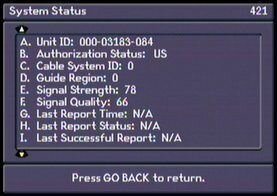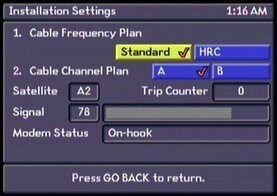Oh yes, he posts in a couple, but it is always either this, or links to his webpage. Same thing he did on DBS.I can't believe he's still responding!,Does he post in anyother thread? I don't think I've ever seen him in anyother thread. He must watch this like a hawk.
What no one will tell you about HDTV...
- Thread starter highdefjeff
- Start date
- Latest activity Latest activity:
- Replies 277
- Views 33K
You are using an out of date browser. It may not display this or other websites correctly.
You should upgrade or use an alternative browser.
You should upgrade or use an alternative browser.
Haha, i notice that a couple of his "interesting observations by other people" are simply threads of him saying exactly what he has said here.
I reported that I hadn't seen that, but you say the guide works perfectly, eh?
Well, even though it is off-subject, here it is. You made me wonder what would happen, so I kept in mind your question while researching the stuff that can be affected by an installer. I am only really interested in stuff that a person can do to increase a bad picture, or optimize a system.
But, the answer is that EPG information is a static, basic, two or three color presentation that doesn't require anywhere near the amount of information to decode vs. a high definition, moving picture. (And even far short the amount of information a standard def digital picture needs.)
You're gettin' this, aren't you?
Yeah but my guide should be a lesser quality like my HD picture since I have 50% signal instead of 90%. I wonder why they put error correction into the guide stream but not the video stream? Stupid engineers!
LOL...
When is Dish going to stop using 5/6 FEC on QPSK and 2/3 on 8PSK since they don't use it anyways?
Of course they do. Can you imagine installers putting up dishes with signal strengths around 60 or so? Customers would be calling on every cloudy day because the signal dropped out, not to mention every time it rains. On a sunny day though, they wouldnt be calling about the picture being blurry, or ghosting (yes ghosting was mentioned at one point).And Dish definitely stresses to their techs that signals exceed "threshold", with "threshold" being their word not mine.
.
Well, regarding the EPG, it is downloaded to the receiver every night, so you can actually access it even during a signal loss (you may have to go into the menu and select the EPG). And since it is already in the receiver, it still looks nice and sharp.
And to back this up, just think about how sharp the menu screens look on a new receiver before you even run a check-switch to acquire the satellite signals.
Now as for all the other stuff, I'm reserving judgement. Thou I will say that some of the situations I've seen doing trouble calls and installations make me think that maybe he isn't as far off-base as people think.
And Dish definitely stresses to their techs that signals exceed "threshold", with "threshold" being their word not mine.
I'll admit as a tech, I'm hesitant to post anymore, but I think everything I've mentioned in this post is common and open knowledge, very basic and "blah".
Actually the EIT and EEPG is sent all day everyday. I'm not about how sharp it is, but it was all sarcasm anyways. We're just having fun with HiiiiiiiiiiidefJeff.
I found a picture of Jeff today

I think many people have used the term (or an equivilant word) threshold.Yeah, but it is the fact that Dish uses the word "threshold" instead of simply saying "minimum".
I'd like to go into more detail but I don't feel comfortable doing it. I know that sounds paranoid but you just never know with Dish.
And it very well could be that Dish's meaning and significance of the "threshold" is totally different from the OP.
If the signal is at an acceptable, locked (threshold) level, then it looks how it looks. No matter if that is 60% or 99%. All that is done after is reduced rain fade, ect. Of course everyone (and Dish or Direct) wants them installed at the highest they can get them, it saves them trouble in the long term, which is probably why they have a "threshold" that they consider acceptable (most people wont call every day at this level)
Oy wey ...
Jeff, go to last tech chat with Dish - there was a question about the term what used in case of fading digital signal; during vocalizing of the question Jim(?) did compare analog and digital levels relevant to quality of a picture.
Jeff, go to last tech chat with Dish - there was a question about the term what used in case of fading digital signal; during vocalizing of the question Jim(?) did compare analog and digital levels relevant to quality of a picture.
Last edited:
I think the funniest part of all of this is that Jeff is using bits and pieces from around the internet to form his argument. If I did that, I'm sure I could come up with a few quotes that, when strung together, say "The Civil War was won by the South."
It's essentially how he's forming his argument.
It's essentially how he's forming his argument.
I really enjoy this thread, just as long as it dies down for a month or so every now and then. Jeff, within the last week, you've added no new information to the discussion. There HAS to be an ulterior motive for this kind of insanity. Maybe he uses all this technical mumbo-jumbo approach to woo his customers into believing that HE'S the ONLY tech who understands how ultra high signal strength increases your HD resolution as compared to high signal strength. He's a good salesman, too bad he's selling shisse.
stop being ignorant! listen up!
signal quality & signal strength are 2 different matters. check out starchoice satellite, I've got pictures of an installation showing quality & strength values.
{There are two parameters that are important for the IRD to propoerly be able to receive a signal SD or HD:
- Composite receive power
- Signal Eb/No (this can also be converted directly to C/N, and is often mistakenly referred to SNR)
The Eb/No, measured in dB, needs to be a minimum value. The size of the dish and the quality of the LNB are what matters here. The length of good quality cable has no effect on this. Poor cable will have a detrimental effect as do most active devices (multi-switches, line amps etc.) as they all add a little bit of noise to the signal.
The composite receive power (measured in dBm) is affected by cable length. Receivers don't really care about what the receive power is as long as it is within a certain window. Typically -35 to 0 dBm. Too low and the receiver can't acquire the signal to try and decode it. To high and you can overdrive the input stages of the receiver.
So, theoretically, you could have too short of a cable length and overdrive the receiver. But this is usually only the case when you have a much larger dish. Too long of a cable really only has an effect when using poor quality cable. Too much loss reduces the receiver power too much, or there is too much resistive loss in the centre conductor of the cable to properly power the LNB over long distances. } digitalhome.ca forum
signal quality & signal strength are 2 different matters. check out starchoice satellite, I've got pictures of an installation showing quality & strength values.
{There are two parameters that are important for the IRD to propoerly be able to receive a signal SD or HD:
- Composite receive power
- Signal Eb/No (this can also be converted directly to C/N, and is often mistakenly referred to SNR)
The Eb/No, measured in dB, needs to be a minimum value. The size of the dish and the quality of the LNB are what matters here. The length of good quality cable has no effect on this. Poor cable will have a detrimental effect as do most active devices (multi-switches, line amps etc.) as they all add a little bit of noise to the signal.
The composite receive power (measured in dBm) is affected by cable length. Receivers don't really care about what the receive power is as long as it is within a certain window. Typically -35 to 0 dBm. Too low and the receiver can't acquire the signal to try and decode it. To high and you can overdrive the input stages of the receiver.
So, theoretically, you could have too short of a cable length and overdrive the receiver. But this is usually only the case when you have a much larger dish. Too long of a cable really only has an effect when using poor quality cable. Too much loss reduces the receiver power too much, or there is too much resistive loss in the centre conductor of the cable to properly power the LNB over long distances. } digitalhome.ca forum
Attachments
Interesting read...
I didn't write this so maybe you guys will read it. I found it an excellent paper.
http://www.iet.ntnu.no/projects/beats/Documents/LarsTelektronikk02.pdf
I didn't write this so maybe you guys will read it. I found it an excellent paper.
http://www.iet.ntnu.no/projects/beats/Documents/LarsTelektronikk02.pdf
Excellent or not, how does it support your argument as it applies hereI didn't write this so maybe you guys will read it. I found it an excellent paper.
http://www.iet.ntnu.no/projects/beats/Documents/LarsTelektronikk02.pdf



